Harare is like a rebel child of the family – unpredictable, a little unkempt, edgy… and exciting to hang out with. After some time away, Zimbabwean Michelle Hardie soaks up the energy and joie de vivre of Zimbabwe’s capital city. Photographs by Melanie Van Zyl.
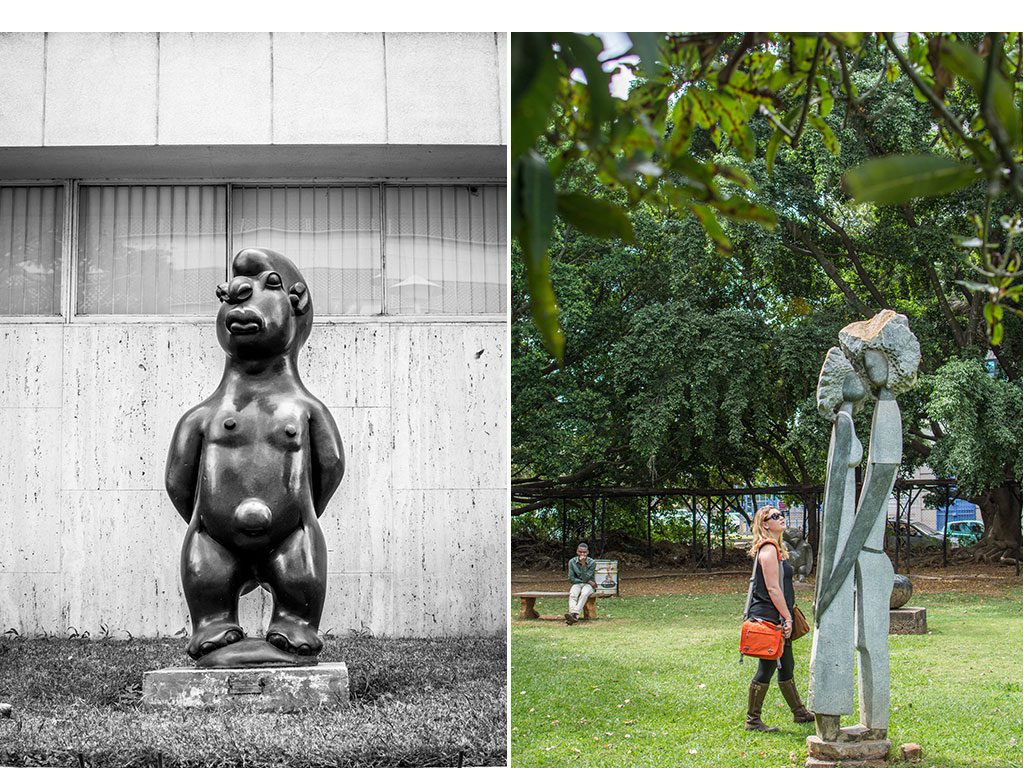
The sculptures at the National Gallery of Zimbabwe have made the country famous for its African artworks.
I climb the stairs wide-eyed and eager. I hear the clip-clip of my shoes hitting the steps, sheeny from decades of swirling crowds browsing, feeling, flicking tags, choosing, deciding. The mirrors are tall and shiny. The banister is still strong. I look up. I have a long way to go, all the way to the top of the world. There are milkshakes and anchovy toast up there. The room is big and still. A man looks up; he sits waiting for his breakfast. News Kademi approaches me. He’s still here after 32 years of polishing cutlery and gently laying menus in front of guests. He smiles. ‘I’m sorry, we don’t serve anchovy toast any more,’ he apologises. ‘Yes, times are very quiet … people don’t come here much. You know, the economic downturn.’
I am back in what used to be the Harrods of Harare, on the third floor of Barbours Departmental Store in First Street, the heart of downtown Harare. But like a mother experiencing an empty nest, the CBD has gone the way of many cities worldwide – buildings that once housed vibrant businesses stand empty as the suburbs have unfurled their green lawns and spacious grounds to beckon trade. I take the lift down. There are three in a row. Only the middle one works. With a flourish, the lift attendant spins the worn brass lever to take us down. ‘I am the pilot,’ he grins.
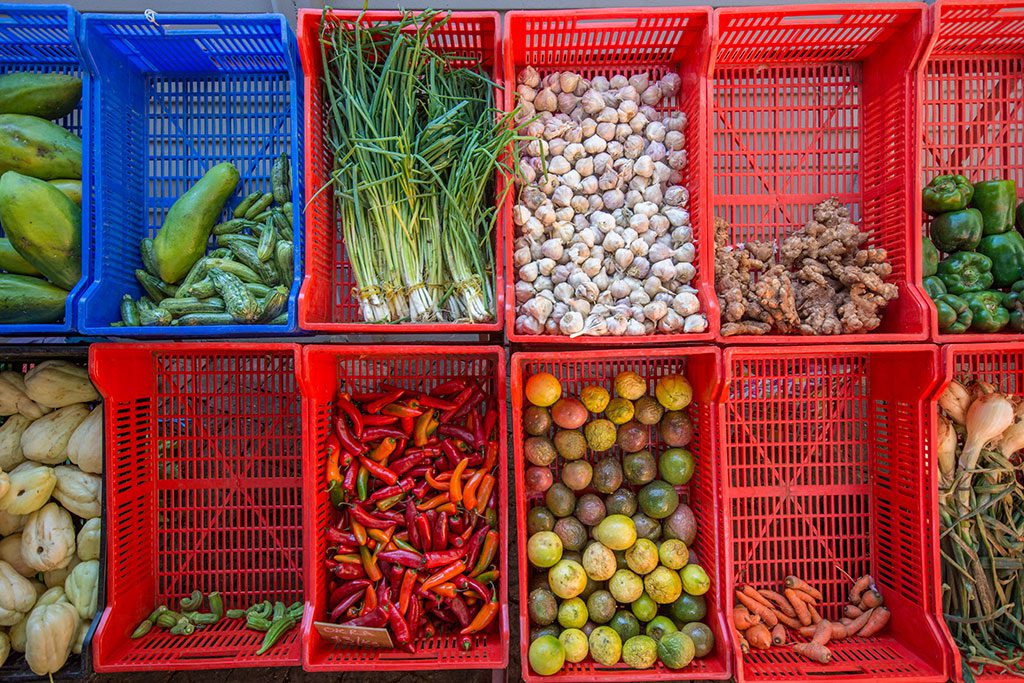 Vegetables at the Maasdorp market.
Vegetables at the Maasdorp market.
The contradictions of this landlocked country are so inimitable and misunderstood that I desire to show you why the capital is worth a visit. A tourist once said to me that for the first time in his life he felt African when he came to Harare – he felt he belonged to the continent. He’s right. Despite its challenges, this is a city that draws you in, that jumbles you up with its present conditions but has you wanting more. The people are as warm and open as the landscape is wide and vivid, alive with fabulous vegetation, magnificent trees and breathtaking rock formations.
I’m thinking about this as I stroll the length of First Street. I feel the abandonment, the pavements buckled by the gnarled roots of old trees, but it doesn’t matter. I have a spring in my step and there’s so much to see in this beautiful city with its flame trees spread across the sky and carpets of jacaranda blooms in springtime. This city is the place where I kissed boys, danced the night away and felt excited. I pass empty shop windows. Ah, but Edgars is still there. And there’s Ratanje Heel Bar. I’ve always loved that name.
I see an endless chain of people zigzagging the street. They are waiting patiently outside Cabs Bank to draw cash. There’s a shortage of this and the government plans to introduce bond notes. Finding humour in dire stories is what Zimbabweans excel at. ‘Bondage notes will not be good for us,’ laughs a teller in a local supermarket. I look past the filthy notes in my purse that have swapped thousands of hands and give her a nice crisp one. I am buying Ndepi, a local publication crammed with things to do, from walks in Mukuvisi Woodlands to shows at Reps Theatre.
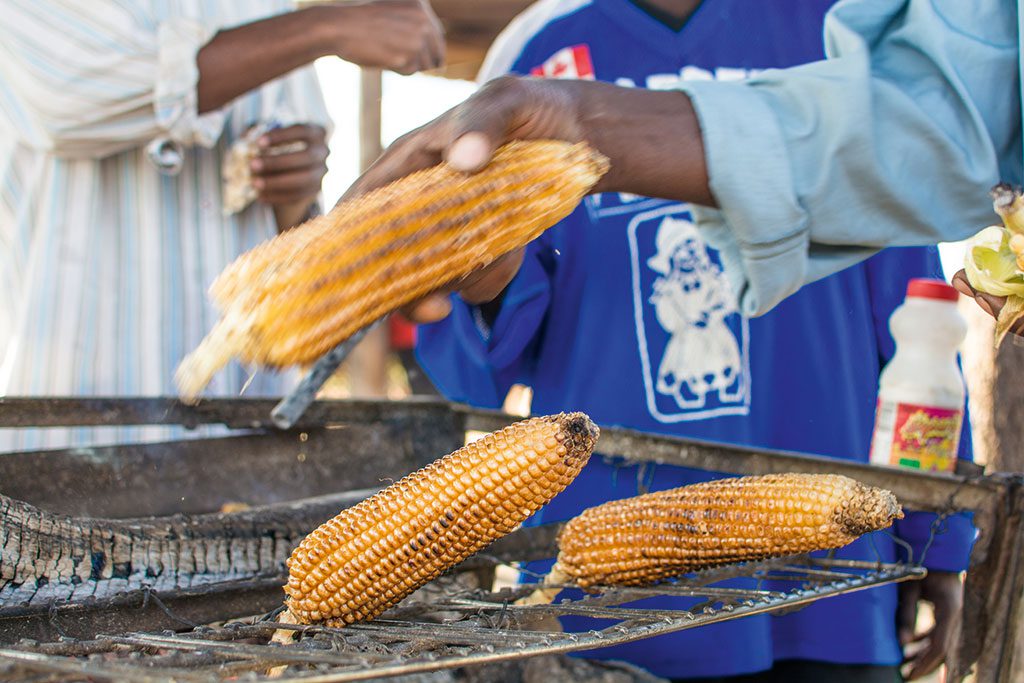
Roasted mealies are sold on roadsides all over the city.
Talk of money is a central theme in Harare – the Chinese whisper of large suitcases packed with US dollars bound for eastern banks. In this way nothing has changed – it’s a familiar song played to a new generation. I am reminded of my mother … the smuggler. Pound notes hidden in a Molico milk tin on a flight to the UK in the days of sanctions. The country had severe foreign-exchange restrictions, which resulted in all sorts of shenanigans. While she had no fear, I was terrified we’d get caught.
I find myself standing at the end of First Street next to a woman sitting on a crate who is not afraid – she has an iPad, an iPhone and big wads of cash balancing on her knees. This is bureau de change Zimbabwean style. And it’s safe. ‘No one here will try to pinch my money,’ she smiles. Residents of Harare are heaped with entrepreneurial skills and the energy to work. Services all over the city are mobile, from airtime sellers on most street corners to independent pothole fixers supported by locals.
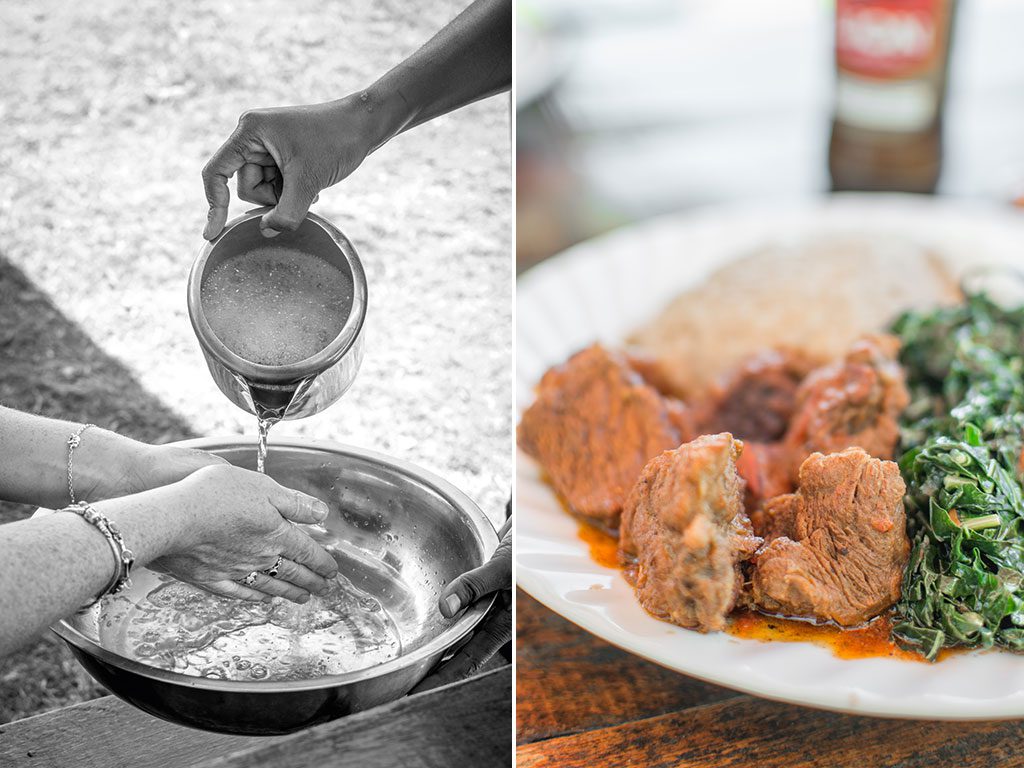
LEFT: Hand washing after a meal at Gava’s. RIGHT: African cuisine from Gava’s that’s cooked over an open fire.
I can’t leave the CBD without visiting historical Meikles Hotel, a landmark in the city centre that’s over 100 years old. I take the lift to the pool deck on the 13th floor, which has a view over African Unity Square, the famous flower sellers (disappointingly, more silk than fresh) and the Parliament Buildings. I’m welcomed into a staff training session and the subject is cocktails – it’s 10am and I’m sipping a delicious gin-based cracker called Soho Ginger.
An hour later, feeling warm and content, I saunter through Unity Square and past the Anglican Cathedral to my car. The sun is high and it’s time to hit the suburbs. ‘How was your time in town?’ asks the parking ticket collector. ‘Hundreds,’ I laugh, imitating a prevailing Zimbo word expressing ‘things are good’.
I am driving along busy Enterprise Road and am looking out for road blocks. There are women sitting too close to the verge, selling sweets and mountains of tomatoes. I dodge jaywalkers through the belch of smoke blown out by the ancient bus ahead.
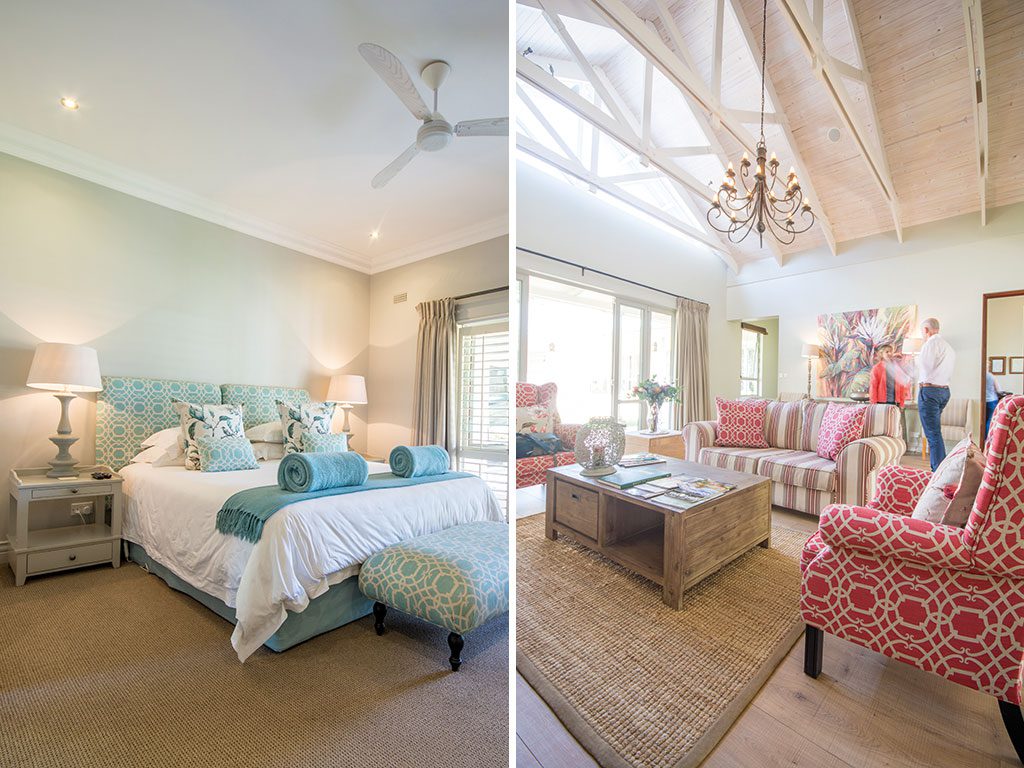
Interior decor at Kingsmead Guesthouse.
Road blocks are a daily routine and massive irritation. Spot fines range from $5 to $20 depending on who’s giving them. I’m assured that I will be stopped and the car checked for a radio licence and a fire extinguisher. I might also be pulled over for other reasons, such as not stopping at a stop sign when I really have stopped but just not for long enough… ‘Don’t worry,’ my sister says, ‘and stay calm.’ I sail past two road blocks and feel triumphant. Hah! And my luck lasts throughout my visit.
The road starts to dip when I reach the vlei area and I look out for the lamp post used by a black-crested eagle as a perch to survey the wetland for prey. Sadly, he’s not there today. I motor on to the suburb of Avondale to meet a young actor. I’ve known Musa Saruro since he was a baby. His expressive eyes are his biggest asset. They are huge and shiny as he enthuses about acting in The Impro Show at Hifa (Harare International Festival of Arts) that attracts international performers.
It’s impossible for me to miss the irony – while it appears that Harare is yearning for stability, her citizens carry on pursuing their passions and creating an environment that’s welcoming, inspired and uplifting. Harare scores ‘hundreds’ in my book.
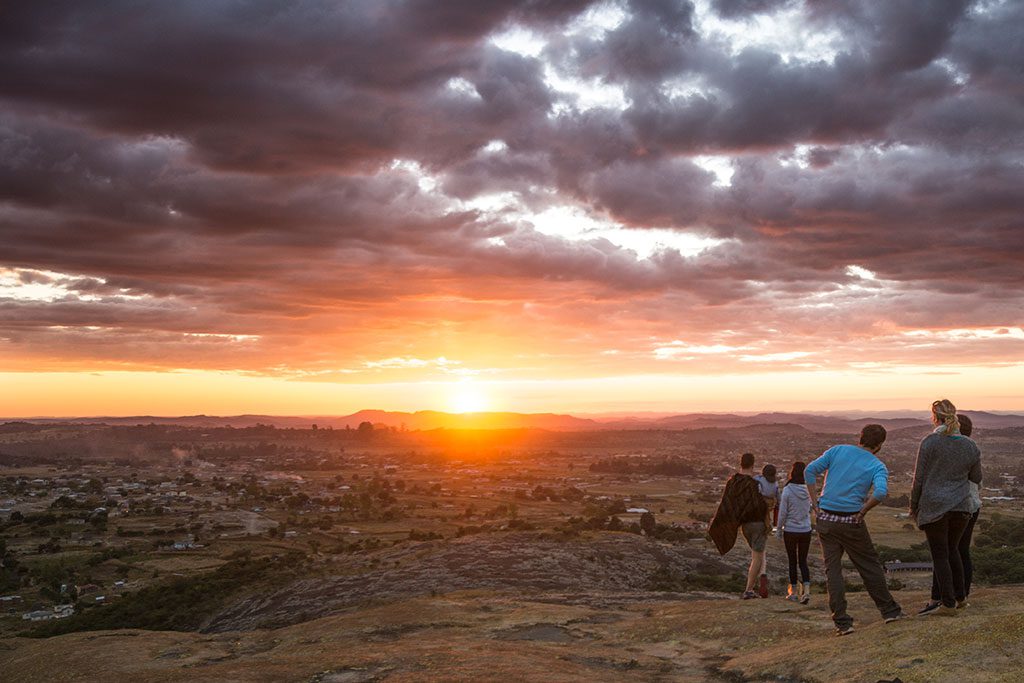
The sun setting on top of the giant rocks at Domboshawa.
Plan your trip
Getting there
I flew from Cape Town via Windhoek on Air Namibia for R5976. There are direct flights from Joburg from R4270 with Fastjet. If you are driving, Joburg is about 540 kilometres from the Beit Bridge border and then 600 kilometres to Harare. airnamibia.com, fastjet.com
When to go
Visit Harare at any time of year. The winters are beautiful with blue skies and sunny days and chilly nights. A really special time is when the jacarandas and flamboyants bloom around September and October ‒ the city is a mass of colour.
Need to know
I took US dollars because of the cash shortage. Don’t bother with rands. Hire a car with a driver as driving is stressful ‒ road blocks, poor signage, potholes and few street lights at night are just some of the hazards. Your accommodation will usually organise transport, from around R885 a day for a car with a driver.
Do this
Take a historical and architectural tour of Harare with Explore Zimbabwe, which includes a visit to the National Gallery and famous Mbare Musika Market. Ask for Ellridge Chimutengo ‒ a knowledgeable guide and skilled at moving through heavy traffic safely. From R590 per person for a half day. +263776270499, mavrossafaris.com
Walk through bush and beautiful msasa and acacia trees at Mukuvisi Woodlands Nature Reserve in the heart of Harare. There are trails of three, five, eight and 10 kilometres through woodlands. From R30 per person. +2634747111, mukuvisiwoodland.co.zw
Browse Amanzi and Maasdorp markets buzzing with locals selling fresh food and Zimbabwean craft. Amanzi is on Friday mornings at 153 Enterprise Road, Lewisam; the other market is in Belgravia’s Maasdorp Avenue on Saturday and Wednesday mornings.
Climb Domboshawa for a spectacular sunset. It’s about a 10-minute walk to the top of the huge granite boulders, with rock paintings along the way. From R75 per person. +2634774208, nmmz.co.zw
Wild is Life is dedicated to the conservation of wildlife in Zim and relies on donations ‒ the ellie orphanage is impressive. Staff go all out to give visitors a memorable experience and while pricey it’s worth it for the work they do. R1384 per person includes a sumptuous high tea, bubbly and canapés at sunset. +263779949821, wildislife.com
Stay here
Kingsmead Guesthouse in leafy Borrowdale is beautifully appointed and has an Internet connection faster than the speed of light! R1615 per person B&B. +263772185415, kingsmeadguesthouse.com
York Lodge oozes charm and comfort and is in amazing, verdant grounds. R1467 per person B&B. +2634776239, yorklodge.com
Sunbird Guest House in Greendale is great for families. There are two houses; book the one with the pool. R726 per person sharing B&B. +263771566715, sunbirdguesthouse.net
Sunshine Guest House in Highlands is managed by charming Rose Mbidzo, who runs a sparkling establishment. R734 per person B&B. +263772353394, sunshineguesthouse.net
Small World Backpackers welcomed me to look around like a long-lost friend. This is clean, very colourful, budget accommodation with shared bathrooms. From R220 per person sharing. +263776986381, smallworldlodge.com
Shop here
Kiki’s gallery in Umwinsidale stocks quality Zimbabwean artefacts and ceramics. +263774125363, kikisgallery.com
Sam Levy’s Village in Borrowdale has loads of shops. Buy local Farfell coffee to take home from Bon Marché or Spar. Coffee connoisseurs, don’t miss out ‒ it’s among the best in the world. samlevysvillage.com
Eat here
Brontë The Garden Hotel in Bains Avenue is pleasant for a coffee in its gorgeous garden. R59 for a cappuccino. +2634707522, brontehotel.com
Sabai Thai is a local favourite in Ballantyne Park, set in the glorious surrounds of a nursery. R135 for a green curry. +263776743775, find it on Facebook.
Pistachio at Sam Levy’s village is a fresh-faced eatery with excellent fare. Meals from R133. +263774280507, Find it on Facebook.
The Village Greek, also at Sam Levy’s Village, has great takeaways. Try the halloumi kebabs for R59. +263772156667, find it on Facebook.
Gava’s in Belgravia serves generous portions of African cuisine cooked on an open fire. From R44 for a meal. +263772381863, find it on Facebook.
This story first appeared in the August 2016 issue of Getaway magazine.
Get this issue →
Our August issue features Mana Pools, great North West parks, and best trips for women.
You may also like
Related Posts
The Northern Cape landscape and its characters are full of life. Here are some of...
read more
If you're feeling a bit tired of the usual scene, take a tip from urban...
read more
The east coast is our very own tropical paradise with warm waters and laid-back vibes....
read more